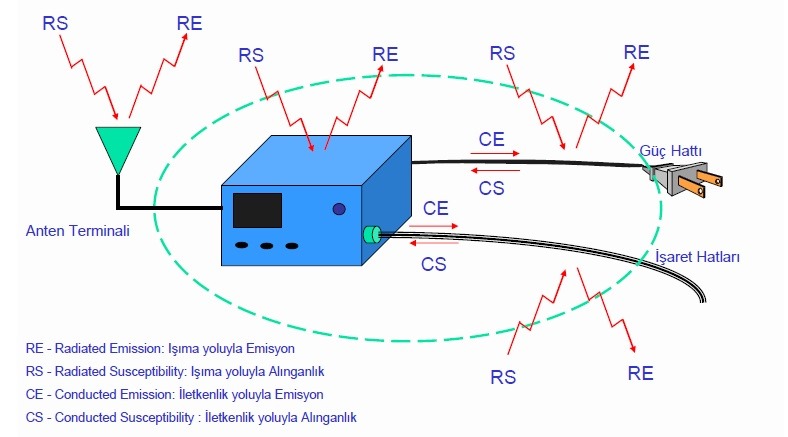EMI EMC TESTS
EMI/EMC Tests are tests performed to ensure that devices operate in harmony with other devices and systems in the electromagnetic environment.
What is EMI-Electromagnetic Interference?
EMI stands for Electromagnetic Interference. As a result of historical developments, the need for frequency planning has emerged over time. For this reason, the Federal Communications Commission (FCC) was first established in the United States of America (USA) in 1979 and various standards were published in this field. Electromagnetic interference is radio frequencies that cause reduced performance, degradation and malfunction of electrical and electronic devices; It is defined as any disruptive effect or sign, whether natural or human. Three conditions are required for a device to be considered electromagnetically compatible:
• Not causing interference within oneself (Self-compatibility)
• Not interfering with other devices
• Not being affected by interference from other sources
Electromagnetic interference is observed as a result of the electromagnetic environment in which the device is affected. All electromagnetic events occurring in a certain region create the electromagnetic environment of that region. The main effects of this electromagnetic environment can be defined as EMI and EMC. If we want to characterize the electromagnetic environment, we encounter two elements:
► Frequency / Time
► Amplitude (Intensity of electromagnetic energy or its value in terms of voltage-current, etc.)
The main reasons for electromagnetic interference are; A list can be made as poor quality cables, printed circuit elements, leaks at connection points, resistors, capacitors, inductors, element changes, electromechanical devices, digital circuit elements, mechanical switches.
What is EMC- Electromagnetic Compatibility?
Electromagnetic compatibility can be defined as any effect achieved in the creation, transmission and reception of electromagnetic energy that will not create electromagnetic interference.
EMI and EMC Verification Tests
There are various tests for electromagnetic compatibility and interference both at the device level and at the platform and system level. The criteria used in these tests are determined as EMI-EMC standards. Electromagnetic Interference (EMI) occurs when Electromagnetic Compatibility (EMC) is lacking. The fact that electrical and electronic devices emit to the environment above the limits determined by standards during their operation or show more sensitivity to this emission than necessary can be considered as Electromagnetic Interference. These standards are the main factors that determine the electromagnetic quality of the product. The standards include two important elements:
► Test limit values
► Test methods
While there are separate standards for military devices, there are also separate standards for commercial devices. EMI - EMC testing has two aspects:
► Emission
► Sensitivity (Immunity)
Emission tests are also done in 2 different ways. Firstly, in emission tests performed through conductivity, the current and voltage parameters of the device or system are measured. While these parameters are measured, current is measured with a current probe and voltage is measured with LISN (Line Impedance Stabilization Network).
In radiant emission tests, the electric field and magnetic field are measured. Electric field antennas or ring antennas are used as the measurement method. Biconical antennas (300-1000 MHz), Log - periodic antennas (300 - 200 MHz) or Horn antennas (1-18 GHz) can also be used. Various antennas suitable for all frequencies are available in our facility and are actively used.
All these measurements can be carried out much more easily using an EMI Receiver. In addition, high fields can be measured by using an electric field probe.

There are 3 test rooms in our facility to be used in EMI/EMC tests:
► Screened Room
► 2 Semi-Aphrodisiac Rooms
►Control Room
A shielded room is a space isolated from the external electromagnetic environment. The Faraday cage is the largest and first example of this. An anechoic room is a space with electromagnetic wave absorbing material on its walls.
Within the scope of our STEST facility, located in Ankara and an organization accredited by TURKAK, we carry out EMI / EMC Tests in accordance with the TS EN ISO / IEC 17025 General Requirements for the Competence of Testing and Calibration Laboratories Standard.
In order to increase the quality and reliability of your products, you can contact us for your Environmental, EMI/EMC and ATP Testing needs.
EMI/EMC Test Chambers Features
| Test Room 1 | Test Room 2 | Measurement unit | |
| Width | 6850 | 13000 | mm |
| Size | 5900 | 10000 | mm |
| Height | 3800 | 9000 | mm |
| Door Dimension | 1000x2000 | 4200x4750 | mm |
| Turntable Diameter | - | 6 | m |
| Turntable Load Carrying Capacity | - | 70 | ton |
| Reflection | Semi Anti-Reflective | Semi Anti-Reflective |
CONTACT BY EMAIL
[email protected]
VOICE COMMUNICATION
+90 (312) 905 06 90

STANDART KONTROL VE TEST HİZMETLERİ A.Ş.
